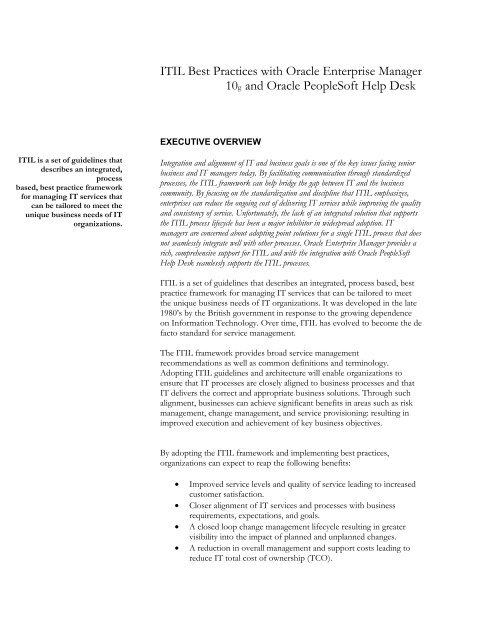ITIL Best Practices with Oracle Enterprise Manager 10g and Oracle ...
ITIL Best Practices with Oracle Enterprise Manager 10g and Oracle ...
ITIL Best Practices with Oracle Enterprise Manager 10g and Oracle ...
Create successful ePaper yourself
Turn your PDF publications into a flip-book with our unique Google optimized e-Paper software.
<strong>ITIL</strong> <strong>Best</strong> <strong>Practices</strong> <strong>with</strong> <strong>Oracle</strong> <strong>Enterprise</strong> <strong>Manager</strong><br />
<strong>10g</strong> <strong>and</strong> <strong>Oracle</strong> PeopleSoft Help Desk<br />
EXECUTIVE OVERVIEW<br />
<strong>ITIL</strong> is a set of guidelines that<br />
describes an integrated,<br />
process<br />
based, best practice framework<br />
for managing IT services that<br />
can be tailored to meet the<br />
unique business needs of IT<br />
organizations.<br />
Integration <strong>and</strong> alignment of IT <strong>and</strong> business goals is one of the key issues facing senior<br />
business <strong>and</strong> IT managers today. By facilitating communication through st<strong>and</strong>ardized<br />
processes, the <strong>ITIL</strong> framework can help bridge the gap between IT <strong>and</strong> the business<br />
community. By focusing on the st<strong>and</strong>ardization <strong>and</strong> discipline that <strong>ITIL</strong> emphasizes,<br />
enterprises can reduce the ongoing cost of delivering IT services while improving the quality<br />
<strong>and</strong> consistency of service. Unfortunately, the lack of an integrated solution that supports<br />
the <strong>ITIL</strong> process lifecycle has been a major inhibitor in widespread adoption. IT<br />
managers are concerned about adopting point solutions for a single <strong>ITIL</strong> process that does<br />
not seamlessly integrate well <strong>with</strong> other processes. <strong>Oracle</strong> <strong>Enterprise</strong> <strong>Manager</strong> provides a<br />
rich, comprehensive support for <strong>ITIL</strong> <strong>and</strong> <strong>with</strong> the integration <strong>with</strong> <strong>Oracle</strong> PeopleSoft<br />
Help Desk seamlessly supports the <strong>ITIL</strong> processes.<br />
<strong>ITIL</strong> is a set of guidelines that describes an integrated, process based, best<br />
practice framework for managing IT services that can be tailored to meet<br />
the unique business needs of IT organizations. It was developed in the late<br />
1980’s by the British government in response to the growing dependence<br />
on Information Technology. Over time, <strong>ITIL</strong> has evolved to become the de<br />
facto st<strong>and</strong>ard for service management.<br />
The <strong>ITIL</strong> framework provides broad service management<br />
recommendations as well as common definitions <strong>and</strong> terminology.<br />
Adopting <strong>ITIL</strong> guidelines <strong>and</strong> architecture will enable organizations to<br />
ensure that IT processes are closely aligned to business processes <strong>and</strong> that<br />
IT delivers the correct <strong>and</strong> appropriate business solutions. Through such<br />
alignment, businesses can achieve significant benefits in areas such as risk<br />
management, change management, <strong>and</strong> service provisioning: resulting in<br />
improved execution <strong>and</strong> achievement of key business objectives.<br />
By adopting the <strong>ITIL</strong> framework <strong>and</strong> implementing best practices,<br />
organizations can expect to reap the following benefits:<br />
• Improved service levels <strong>and</strong> quality of service leading to increased<br />
customer satisfaction.<br />
• Closer alignment of IT services <strong>and</strong> processes <strong>with</strong> business<br />
requirements, expectations, <strong>and</strong> goals.<br />
• A closed loop change management lifecycle resulting in greater<br />
visibility into the impact of planned <strong>and</strong> unplanned changes.<br />
• A reduction in overall management <strong>and</strong> support costs leading to<br />
reduce IT total cost of ownership (TCO).

















